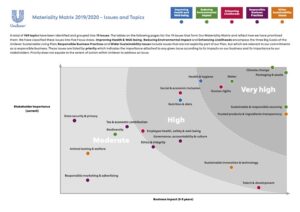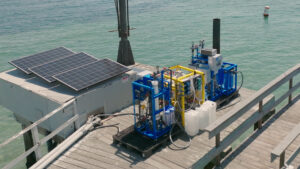
Every year manufacturers churn out some 100 billion garments, making fashion one of the world’s biggest industries generating more than $1.7 trillion in revenues and employing tens of millions of people.
But the environmental cost of textile manufacturing is huge, ranging from the consumption of water to irrigate cotton farms to the burning of fossil fuels to power factories. The combined textile and apparel sectors contribute as much as 10 percent of global greenhouse gas emissions.
With the rise of fast fashion, the industry produces mountains of waste that contribute some 92 million tons to landfills every year, according to Earth.org. That’s the equivalent of a garbage truck full of clothes waste every second.
If the world is to meet its ambitious Paris Agreement climate commitments, the industry needs to take quick and substantive action to reduce its harm.
With the rise of fast fashion the industry contributes 92 million tons of waste each year — the equivalent of a garbage truck full of clothes every second.
Global brands and retail chains drive activities in the textile and apparel value chain, contracting production to developing country manufacturers, and they have a key role in making the industry sustainable. Collaboration with policymakers, financial institutions such as the International Finance Corporation (IFC), and consumers will also be essential to achieve water conservation, energy decarbonization and responsible waste management practices.
The industry has set a goal of getting to net-zero greenhouse gas emissions by 2050 under the Fashion Industry Charter for Climate Action, and the EU is requiring the industry to attain circularity by 2030. Some major brands and suppliers are already taking action. Levi Strauss & Co. is working with suppliers to improve their performance as part of its efforts to achieve a 40 percent absolute reduction in supply chain including Scope 3 emissions by 2025. Luxury group Kering has launched pilots on regenerative agriculture and supported two dozen mill suppliers to improve their water and energy efficiency.
In Bangladesh, DBL Hamza Textiles Ltd. — a key supplier to PUMA, Inditex and others — has installed solar systems, ramped up wastewater treatment and incorporated energy-efficient machinery, with IFC investing $22 million to help pay for the technologies needed.
The industry has set a goal of getting to net-zero emissions by 2050 — and the EU is requiring the industry to attain circularity by 2030.
While the pandemic temporarily dampened apparel demand and disrupted supply chains, the crisis offered an unexpected boost for sustainability. "Nearshoring" of production closer to consumer markets has not only helped global brands alleviate supply chain vulnerabilities but also lowered transport-related emissions. It has provided opportunities for factories in Morocco, Tunisia, Egypt and Jordan, supplying European brands, and Central America, supplying North America, to invest in more energy and water-efficient production lines.
Meanwhile, travel restrictions implemented during the pandemic popularized the use of 3D digital design, reducing travel-related emissions and the volume of waste fabrics from sample sewing. Integration and shortening of textile and apparel supply chains by some countries has reduced transport-related emissions and strengthened accountability and transparency. For example, a major garment producer in Bangladesh is branching out into fabric and yarn manufacturing, replacing imports from China and elsewhere.
Travel restrictions implemented during COVID popularized the use of 3D digital design, reducing travel emissions and waste fabrics from sample sewing
Still, the vast global textile and apparel industry faces a complicated path to net zero. Long and complex supply chains make it difficult for global brands to enforce, or even monitor, manufacturing processes for sustainability, especially among smaller suppliers. Another challenge centers on the critical role that retailers and consumers play in the waste and recycling part of the cycle, with an estimated 92 billion tonnes of garments ending up in landfills each year.
Shifting behavior will be essential to achieving a circular economy in the industry, but companies must also change the manufacturing process, which accounts for the largest share of water use, pollution and greenhouse gas emissions.
Curbing water waste and pollution will start with big players
Water use and pollution rank among the industry’s biggest challenges, with about one-fifth of the wastewater worldwide originating from fabric dyeing and treatment. Industry organization ZDHC has helped establish minimum standards aimed at reducing chemical pollution, and existing technologies can reduce water use and pollution, such as in the dyeing process. These innovations require large investments, limiting adoption to major players; industrial parks with centralized wastewater treatment could work for smaller players.
At current rates, the industry’s greenhouse gas emissions are projected to surge more than 50 percent by 2030, with production processes accounting for the lion’s share. Renewable energy offers the most promising solution and larger suppliers and manufacturers such as IFC partner Sanko Textile are installing solar panels. Reducing emissions will be more challenging for the industry’s countless smaller players, while consumers could deliver 186 million tonnes of carbon emission reductions — along with water savings — by cutting back on washing and drying.
Innovation needed
Current fibers (cotton, synthetics and cellulosic fibers) all have varying negative impacts on the environment. The industry can alleviate these by adopting new techniques and technologies, from applying micro-irrigation for cotton farms to replacing fossil fuel-based synthetics with biodegradable synthetics, such as those made from starch. Wider adoption and economies of scale should make innovative materials more affordable.
Curbing waste through circularity
Overproduction and fast fashion have contributed to a major waste problem. Currently, less than 1 percent of textile waste is recycled into new fibers for clothing, translating into more than $100 billion in lost material annually. Virtual try-on, 3D design and fashion rental platforms can help alleviate waste, but the most impactful solution will be converting to a circular economy.
Fully scaled, existing recycling technologies could deliver 75 percent "textile-to-textile recycling" back into the system and 5 percent recycled feedstock from other industries. This potential multibillion-dollar market would require at least $5 billion in recycling-technology investment by 2026, and more for collection and sorting infrastructure.
Global apparel brands and their network of suppliers face increasing pressure from consumers, governments, workers and investors to decarbonize their operations, conserve resources, reduce waste and improve labor conditions.
Over the past few decades, even as production has boomed to meet the needs of a growing global population, textile and apparel manufacturers have made significant progress. However, it will take even greater collaboration across the value chain along with support from policymakers and international financial institutions for the industry to secure a zero-carbon future.
This report is part of a series on sustainability by the International Finance Corporation examining the opportunities and challenges facing various industries and the role that IFC can play to help overcome these challenges and contribute to a greener planet.
- SEO Powered Content & PR Distribution. Get Amplified Today.
- PlatoData.Network Vertical Generative Ai. Empower Yourself. Access Here.
- PlatoAiStream. Web3 Intelligence. Knowledge Amplified. Access Here.
- PlatoESG. Carbon, CleanTech, Energy, Environment, Solar, Waste Management. Access Here.
- PlatoHealth. Biotech and Clinical Trials Intelligence. Access Here.
- Source: https://www.greenbiz.com/article/worlds-clothing-boom-climate-changer
- :has
- :is
- :not
- $UP
- 1
- 100
- 2025
- 2026
- 2030
- 2050
- 3d
- 50
- 7
- 75
- a
- About
- Absolute
- According
- accountability
- Accounts
- Achieve
- achieving
- across
- Action
- activities
- Adopting
- Adoption
- affordable
- Agreement
- aimed
- All
- alleviate
- along
- already
- also
- ambitious
- america
- among
- an
- and
- Another
- apparel
- Applying
- ARE
- AS
- At
- attain
- back
- Bangladesh
- BE
- behavior
- Big
- Biggest
- Billion
- boom
- boost
- brands
- burning
- but
- by
- CAN
- carbon
- cellulosic
- Centers
- central
- centralized
- chain
- chains
- challenge
- challenges
- challenging
- change
- Changer
- chemical
- China
- circular
- circular economy
- Climate
- closer
- clothes
- Clothing
- CO
- collaboration
- collection
- combined
- commitments
- Companies
- complex
- complicated
- conditions
- CONSERVATION
- consumer
- Consumers
- consumption
- contracting
- contribute
- contributed
- contributes
- converting
- CORPORATION
- Cost
- could
- countries
- country
- Covid
- crisis
- critical
- Current
- Currently
- cutting
- cycle
- decades
- decarbonization
- decarbonize
- deliver
- Demand
- Design
- developing
- difficult
- digital
- dozen
- drive
- during
- each
- earth
- economies
- Economies of Scale
- economy
- efficiency
- efforts
- Egypt
- elsewhere
- emission
- Emissions
- employing
- ending
- energy
- energy efficiency
- enforce
- Environment
- environmental
- Equivalent
- especially
- essential
- establish
- estimated
- Ether (ETH)
- EU
- European
- Even
- Every
- Examining
- example
- existing
- fabric
- fabrics
- Face
- faces
- facing
- factories
- Farms
- Fashion
- FAST
- few
- fibers
- finance
- financial
- Financial institutions
- For
- fossil
- fossil fuels
- from
- fuels
- full
- future
- GAS
- generating
- getting
- Global
- goal
- Governments
- greater
- greener
- greenhouse gas
- Greenhouse gas emissions
- Group
- Growing
- harm
- Have
- help
- helped
- However
- HTTPS
- huge
- impactful
- Impacts
- implemented
- imports
- improve
- in
- Including
- Incorporated
- increasing
- industrial
- industries
- industry
- industry’s
- Infrastructure
- innovations
- innovative
- installing
- institutions
- integration
- International
- into
- Invest
- investing
- investment
- Investments
- Investors
- IT
- ITS
- Jordan
- jpg
- Key
- labor
- large
- larger
- largest
- least
- less
- lines
- Long
- lost
- lowered
- Ltd
- Luxury
- machinery
- made
- major
- make
- Making
- management
- Manufacturers
- manufacturing
- Market
- Markets
- material
- materials
- McKinsey
- Meet
- million
- millions
- minimum
- Monitor
- more
- morocco
- most
- much
- must
- needed
- needs
- negative
- net
- net-zero
- network
- New
- North
- north america
- of
- offered
- Offers
- on
- ONE
- only
- Operations
- opportunities
- or
- organization
- originating
- Other
- Others
- out
- Overcome
- pandemic
- panels
- paris
- Paris Agreement
- parks
- part
- partner
- past
- path
- Pay
- People
- percent
- performance
- Pilots
- planet
- Platforms
- plato
- Plato Data Intelligence
- PlatoData
- Play
- players
- policymakers
- Pollution
- population
- potential
- power
- practices
- pressure
- Problem
- process
- processes
- producer
- produces
- Production
- Progress
- projected
- promising
- provided
- PUMA
- Quick
- ranging
- rank
- Rates
- recycled
- recycling
- reduce
- reduce waste
- Reduced
- reducing
- reducing emissions
- reductions
- regenerative
- Renewable
- renewable energy
- report
- require
- Resources
- responsible
- restrictions
- retail
- retailers
- revenues
- Rise
- Role
- Savings
- Scale
- Second
- Sectors
- secure
- Series
- set
- Share
- should
- significant
- smaller
- solar
- solar panels
- solution
- some
- standards
- start
- strengthened
- such
- supplier
- suppliers
- supply
- supply chain
- Supply chains
- supplying
- support
- surge
- Sustainability
- sustainable
- synthetics
- system
- Systems
- Take
- taking
- techniques
- Technologies
- tens
- textiles
- than
- that
- The
- the world
- their
- These
- they
- this
- those
- Through
- to
- tons
- Transparency
- travel
- treatment
- truck
- try-on
- Tunisia
- two
- under
- Unexpected
- use
- value
- various
- varying
- Vast
- Virtual
- volume
- Vulnerabilities
- washing
- Waste
- Water
- which
- while
- wider
- will
- with
- Work
- workers
- working
- world
- world’s
- worldwide
- would
- year
- zephyrnet
- zero











